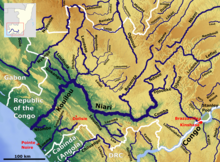
The Itaipu Dam is a hydroelectric dam on the Paraná River located on the border between Brazil and Paraguay. The construction of the dam was first contested by Argentina, but the negotiations and resolution of the dispute ended up setting the basis for Argentine–Brazilian integration later on.

The Kouilou-Niari River—also spelled Kwilu, Kwila, or Kwil—is the most important river flowing to the Atlantic Ocean of the Republic of the Congo coast. Moreover, it entire drainage area is completely in the Republic of the Congo. The river is called the Kouilou River while flowing in the coastal region of the Kouilou till the Sounda gorges. Upstream from the Gorges, its name is the Niari River and it flows through the Niari Valley. The river combines with the Louessé, the Loudima and the Bouenza River and eventually flows into the Atlantic Ocean. It covers about 560 km from its origin in the Batéké Plateau of The Congo to its mouth at the coast.
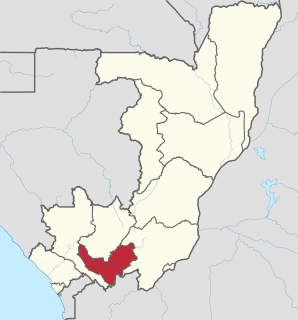
Bouenza is a department of the Republic of the Congo in the southern part of the country. It borders the departments of Lékoumou, Niari, and Pool, and internationally, the Democratic Republic of the Congo. The regional capital is Madingou. Towns and cities include Loudima, Mouyondzi, Loutété and Nkayi.

The Chenab River is a major river that flows in India and Pakistan, and is one of the 5 major rivers of the Punjab region. It rises in the upper Himalayas in the Lahaul and Spiti district of Himachal Pradesh state, India, and flows through the Jammu region of Jammu and Kashmir into the plains of Punjab, Pakistan, before flowing into the Indus River near the city of Uch Sharif. The waters of the Chenab were allocated to Pakistan under the terms of the Indus Waters Treaty.

The Inga Dams are two hydroelectric dams connected to one of the largest waterfalls in the world, Inga Falls. They are located in the western Democratic Republic of the Congo and 140 miles southwest of Kinshasa.
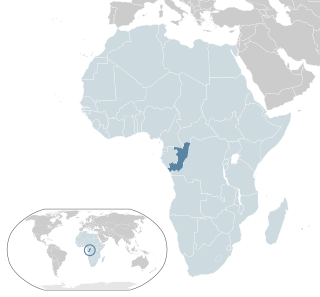
The Second Republic of the Congo Civil War was the second of two ethnopolitical civil conflicts in the Republic of the Congo, beginning on 5 June 1997 and continuing until 29 December 1999. The war served as the continuation of the civil war of 1993–94 and involved militias representing three political candidates. The conflict ended following the intervention of the Angolan army, which reinstated former president Denis Sassou Nguesso to power.
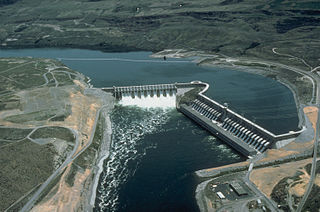
Run-of-river hydroelectricity (ROR) or run-of-the-river hydroelectricity is a type of hydroelectric generation plant whereby little or no water storage is provided. Run-of-the-river power plants may have no water storage at all or a limited amount of storage, in which case the storage reservoir is referred to as pondage. A plant without pondage is subject to seasonal river flows, thus the plant will operate as an intermittent energy source. Conventional hydro uses reservoirs, which regulate water for flood control, dispatchable electrical power, and the provision of fresh water for agriculture.

The Raidāk River, also called Wang Chhu or Wong Chhu in Bhutan, is a tributary of the River Brahmaputra, and a trans-boundary river. It flows through Bhutan, India and Bangladesh.

Alphonse van Gèle, also written van Gele or Vangele, was a Belgian soldier who served as the Vice-Governor General of the Congo Free State from December 1897 until January 1899. He established the Equator Station, or Station de l’Équateur, today Mbandaka, and concluded a treaty with the powerful Zanzibar trader Tippu Tip at the Stanley Falls station, today Kisangani. He is known for having confirmed that the Uele River was the upper part of the Ubangi River.

Upoto was a village on the right bank of the Congo River, now a district of Lisala in the Mongala province of the Democratic Republic of the Congo.
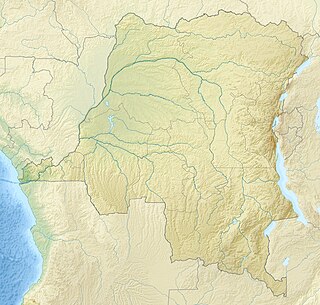
The Gada River is a left tributary of the Uele River, which it joins downstream from Niangara in the Haut-Uélé province of the Democratic Republic of the Congo.

Guillaume-Camille Casman was a Belgian soldier, explorer and administrator for the International African Association and the Congo Free State. He was briefly commander of the Équateur station on the upper Congo.

The Bundi River is a river of the Democratic Republic of the Congo. It is a right tributary of the lower Congo River that enters the river below the Inga Falls. If the proposed Grand Inga Dam project goes ahead, the river valley will be flooded to form a huge lake.
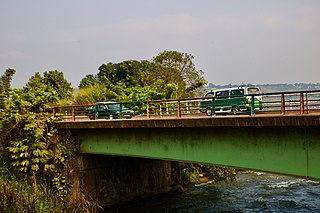
The Djoué River is a river of the Republic of the Congo. It is a right tributary of the Congo River.

Edmond-Winnie-Victor Hanssens was a Belgian soldier and colonial administrator. He did much to establish the Belgian presence on the Upper Congo River in the last two years of his life.

The Moukoukoulou Dam is a hydoelectric dam on the Bouenza River, built by Chinese technicians and commissioned in 1979 to supply energy to Pointe-Noire. It is the main source of power to the south of the country. Due to fluctuating water levels and to poor maintenance of the plant and transmission network it often delivers far less than its nominal 74 megawatts.

Arvid Mauritz Wester was a Swedish soldier who was active in the service of the Belgians in the Congo. For almost two years he commanded the remote station at Stanley Falls, where he had to deal with hostile local people and Arabs.

Sten Edvard Gleerup, or Edde Gleerup, was a Swedish soldier and explorer. He was the first Swede and eighth European to cross Africa.
This page is based on this
Wikipedia article Text is available under the
CC BY-SA 4.0 license; additional terms may apply.
Images, videos and audio are available under their respective licenses.
